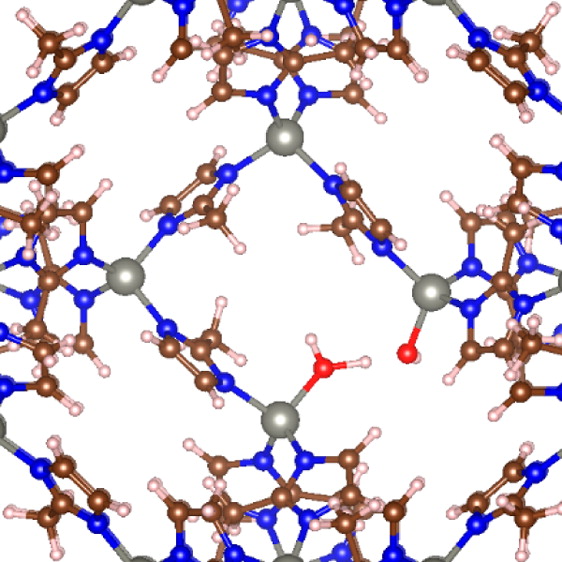Investigating the impact of localized defects on the thermal and mechanical properties of ZIF-8
Investigating the impact of localized defects on the thermal and mechanical properties of ZIF-8
Promotor(en): V. Van Speybroeck /18NANO18 / Model and software development, Nanoporous materialsCrystalline, nanoporous materials such as metal-organic frameworks (MOFs) have been proposed for a variety of industrial applications, such as energy storage, gas separation, and the capture of greenhouse gases. These scaffold-like materials, composed of inorganic moieties connected through organic ligands, were originally thought of as being perfectly ordered. However, recent advances in experimental characterization tools have disproven this ideal picture, and it has become increasingly clear that spatial disorder in the form of localized defects is inherently present in these materials [1]. While these defects may jeopardize the mechanical and thermal stability of MOFs, they may also endow the material with a superior performance in gas adsorption, gas separation, or heterogeneous catalysis with respect to their defect-free analogues. As a result, localized defects in MOFs have emerged as an alternative pathway to design defect-engineered MOFs towards specific applications [2].
To fully exploit the potential of defects, however, it is essential to reliably predict how the presence and distribution of defects will alter the mechanical and thermal stability of these MOFs, to ensure that defect-engineered MOFs can be adopted for real-life applications. In a recent study by the Center for Molecular Modeling (CMM), the impact of localized defects on the mechanical stability of one of the prototypical MOFs, UiO-66, was investigated (see Figure 1) [3]. By including different linker defects in the material, as indicated in Figure 1, we were able to determine that the stability of the material is not only influenced by the number of defects, but also, and primarily, by the distribution of these defects in the material. In this research proposal, we intent to perform a similar study of imperfections in ZIF-8 and explain their influence on the deviations of thermal and mechanical properties from the perfect crystal.

Goal
Recently, Schmidt and co-workers performed an extensive study of possible localized defect mechanisms in ZIF-8, , an example of which is indicated in Figure 2, by making the analogy with the well-known class of zeolites [4]. In this thesis proposal, we first aim to validate their findings by performing quantum mechanical calculations of the (defective) crystal and representative cluster models, and propose other defect mechanisms based on our earlier experience with defected MOFs. Furthermore, the energetics of these hypothetical defects will be systematically evaluated, which will allow to formulate the most probable defect mechanisms present in ZIF-8.

In a next step, force field models for these defective structures will be developed, based on the generated quantum mechanical data using an in-house developed protocol [5]. A force field approximates the complex potential energy surface by simple analytical expressions and allows to simulate larger systems for a longer time in contrast with a full quantum mechanical treatment. Properties such as the bulk modulus, shear modulus, loss-of-crystallinity pressure, and thermal expansion will be determined using computational procedures which were recently developed at the CMM, and compared with available experimental data to confirm our atomistic models. In this way, we will acquire and explain the real crystal structure of ZIF-8 for the first time. Moreover, if possible, these findings will be expanded to also account for ZIF-8 surfaces, so to account for the finite size of these MOF crystals.
The student will be actively coached to make him/her acquainted with the advanced simulations techniques early in the thesis year, and to transfer necessary programming skills needed to perform the research.
Aspects
Physics aspect: Microscopically identifying the impact of defects on the stability of MOFs.
Engineering aspect: Design of defect-engineered MOFs with a substantial thermal and mechanical stability.
- Study programmeMaster of Science in Engineering Physics [EMPHYS], Master of Science in Physics and Astronomy [CMFYST]ClustersFor Engineering Physics students, this thesis is closely related to the cluster(s) NANO, MODELINGKeywordsdefects, Disorder, Metal-organic frameworks, mechanical stability, Thermal propertiesReferences
[1] T. D. Bennett, A. K. Cheetham, A. H. Fuchs and F.-X. Coudert, “Interplay Between Defects, Disorder and Flexibility in Metal-Organic Frameworks,” Nat. Chem., vol. 9, no. 1, pp. 11-16, 2017.
[2] Z. Fang, B. Bueken, D. E. De Vos and R. A. Fischer, “Defect-Engineered Metal-Organic Frameworks,” Angew. Chem., Int. Ed., vol. 54, no. 25, pp. 7234-7254, 2015.
[3] S. M. J. Rogge, J. Wieme, L. Vanduyfhuys, S. Vandenbrande, G. Maurin, T. Verstraelen, M. Waroquier, V. Speybroeck and V., "Thermodynamic Insight in the High-Pressure Behavior of UiO-66: Effect of Linker Defects and Linker Expansion," Chem. Mater., vol. 28, no. 16, pp. 5721-5732, 2016.
[4] C. Zhang, C. Han, D. S. Sholl and J. R. Schmidt, “Computational Characterization of Defects in Metal–Organic Frameworks: Spontaneous and Water-Induced Point Defects in ZIF-8,” J. Phys. Chem. Lett., vol. 7, no. 3, pp. 459-464, 2016.
[5] L. Vanduyfhuys, S. Vandenbrande, T. Verstraelen, R. Schmid, M. Waroquier and V. Van Speybroeck, "QuickFF: A Program for a Quick and Easy Derivation of Force Fields for Metal-Organic Frameworks," J. Comput. Chem., vol. 36, no. 13, pp. 1015-1027, 2015.


